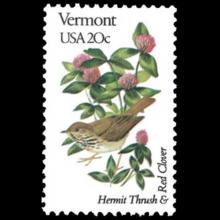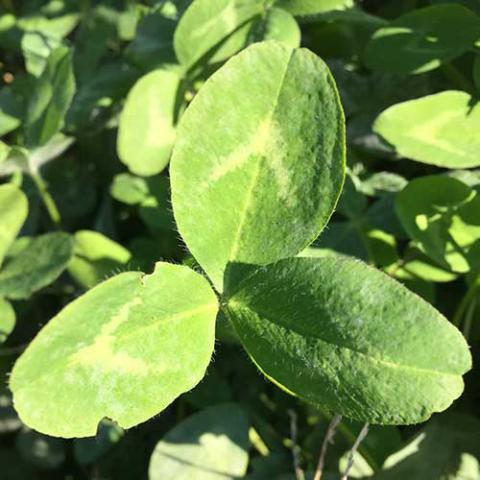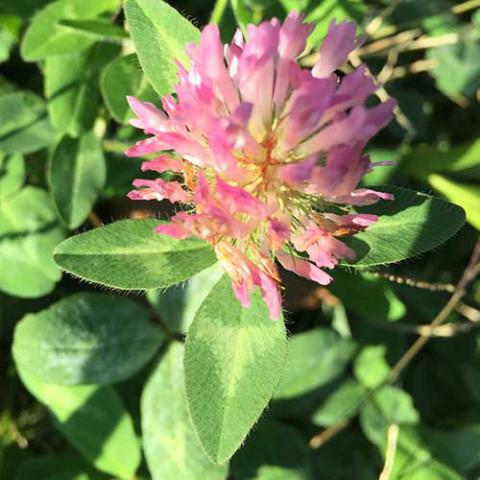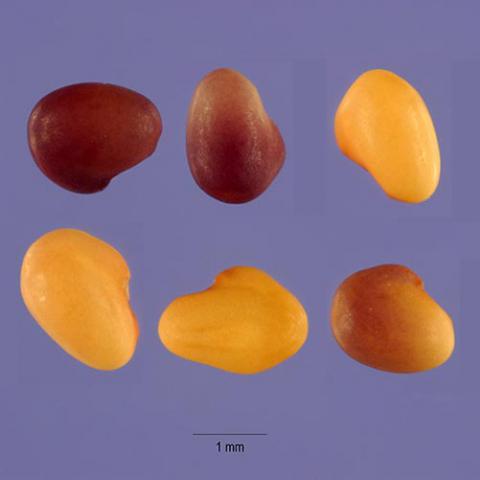NAME(S)
TAXONOMY
PLANTAE ID
THERAPEUTIC
United States
Issued:
Stamp:
Trifolium pratense
United States
Issued:
Stamp:
Trifolium pratense
United States
Issued:
Stamp:
Trifolium pratense
From the Ground Up: Red clover
Red clover is native to Europe and is now widely distributed throughout North America. It is most commonly known as a ground cover crop.
Deborah Brandt, RN, September 1, 2016
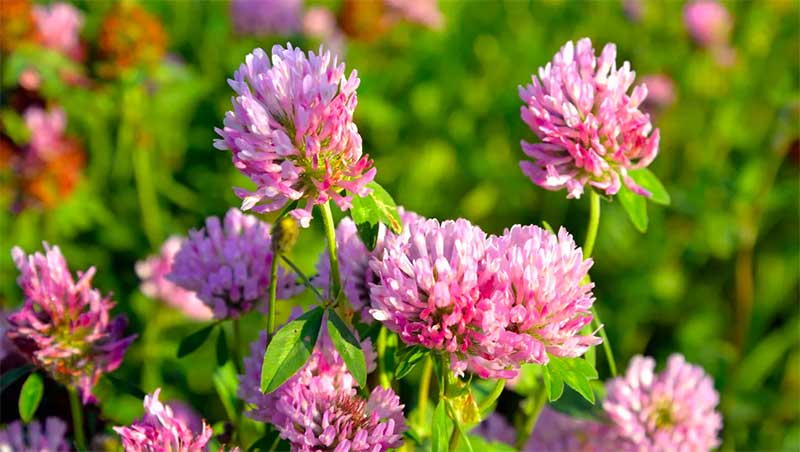
Red clover (Trifolium pratense) is found in mountain grazing areas about 6,000 feet and higher. It has pink/red blossoms that are up to an inch across. A perennial, it grows to a height of up to 32 inches. The leaves are three parted, with many branches. Red clover is native to Europe and is now widely distributed throughout North America. It is most commonly known as a ground cover crop.
In early accounts of European herb lore, the flowers and seeds were boiled together and applied topically to boils and growths. The juice from the leaves was also used in the 1600s “to clear the eyes of any film beginning to grow over them, or to soothe when bloodshot and hot.”
Red clover was introduced to the Americas from Europe and became widely used by native peoples. The leaves and flowers were used as an infusion (tea) for whooping cough, a general cancer remedy, and more specifically stomach cancer, menopause, and “blood medicine” meaning blood purifying. It has a history of use as an ointment for venomous bites. It also became a food crop; tribes in California and Arizona cooked clover. By the 18th and 19th centuries it was predominantly used as feed for cattle sheep and horses. I have heard of it being incorporated into bread. I’ve never tasted it, but sounds intriguing.
In the 1800s, American doctors began taking red clover seriously, possessing “valuable detergent properties in diseases of the blood.” The pharmaceutical company Parke-Davis cited it for treatment of pellagra (niacin deficiency), scrofula (tuberculosis of the parotid glands), syphilis, whooping cough, and as an external wash for ulcers. Red clover blossoms are included in the 20-21st editions of the United States Dispensary and the 1916 National Formulary.
Modern use is not much different than historical. It is not likely anyone uses it anymore for pellagra, syphilis or tuberculosis, however. It is still considered useful for eczema in combination with other herbs as well as for coughs. The British Herbal Compendium (1992) and the British Herbal Pharmacopeia cite red clover as a "dermatological agent and mildly antispasmodic and expectorant" for coughs. In 2003 the United States Pharmacopeia and National Formulary came back on board with monographs of red clover. It has some constituents that may cause it to be helpful for easing menopausal symptoms. Red clover seems to have an affinity for chronic bronchial and throat conditions. It is a gentle remedy for spasmodic coughs, easing expectoration.
The tea is good tasting and mineral rich. Because mineral rich herbs tend to be alkalinizing, it can help the body detox from accumulated metabolic wastes, which are mostly acidic. Stressors that put a high physical demand on the body such as infection, chronic disease or physically demanding work can be helped with red clover tea because of its buffering effect.
To make a tea of the dry blossoms, use a teaspoon of dried blossoms per cup of tea. Simmer the blossoms in a cup or two of water for a few minutes. Let it steep another few minutes and strain. Drink 2 to 3 cups a day. It is a pleasant tea to help your body rid itself of wastes when sick.
Reference: Las Cruces Sun News
Genus species (Plantae): Trifolium pratense
Trifolium pratense (red clover) is a herbaceous species of flowering plant in the bean family Fabaceae, native to Europe, Western Asia and northwest Africa, but planted and naturalised in many other regions.
Description
It is a herbaceous, short-lived perennial plant, variable in size, growing to 20–80 cm tall. The leaves are alternate, trifoliate (with three leaflets), each leaflet 15–30 mm long and 8–15 mm broad, green with a characteristic pale crescent in the outer half of the leaf; the petiole is 1–4 cm long, with two basal stipules that are abruptly narrowed to a bristle-like point. The flowers are dark pink with a paler base, 12–15 mm long, produced in a dense inflorescence, and are mostly visited by bumblebees.
Distribution
The red clover is found natively in Europe, Western Asia, and northwest Africa, but it has been naturalized in other continents, like North and South America. Specifically, the red clover was brought to Argentina and Chile over 100 years ago, although it is not clear now exactly it was introduced. The red clover has become increasingly important as a source of economic stability in Chile, which has made the need for pollinators even more important. One important pollinator, which was also brought from Europe, is Bombus ruderatus, or the large garden bumblebee. This bumblebee has been one of the important pollinators of red clover in South America and other countries like New Zealand.
Uses
It is widely grown as a fodder crop, valued for its nitrogen fixation, which increases soil fertility. For these reasons, it is used as a green manure crop. Several cultivar groups have been selected for agricultural use, mostly derived from T. pratense var. sativum. It has become naturalised in many temperate areas, including the Americas and Australasia as an escape from cultivation.
Red clover is commonly used to make a sweet-tasting herbal tea. It is an ingredient in some recipes for essiac tea.
Medical uses
Trifolium pratense is used in traditional medicine of India as deobstruent, antispasmodic, expectorant, sedative, anti-inflammatory and antidermatosis agent.
In alternative medicine, red clover is promoted as a treatment for a variety of human maladies, including coughs, disorders of the lymphatic system and a variety of cancers. However, according to the American Cancer Society, "available clinical evidence does not show that red clover is effective in treating or preventing cancer, menopausal symptoms, or any other medical conditions".
Dietary amounts of red clover are safe, but medicinal quantities may cause rash-like reactions, muscle ache, headache, nausea, vaginal bleeding in women, and slow blood clotting.
Red clover contains coumestrol, a phytoestrogen. Due to its activity on oestrogen receptors, red clover is contraindicated in people with a history of breast cancer, endometriosis, ovarian cancer, uterine cancer, uterine fibroids or other oestrogen-sensitive conditions, although some authors have suggested the high isoflavone content counteracts this, and even provides benefits in these conditions.
Due to its coumarin derivatives, T. pratense should be used in caution in individuals with coagulation disorders or currently undergoing anticoagulation therapy.
It is metabolised by CYP3A4 and therefore caution should be used when taking it with other drugs using this metabolic pathway.
Diseases
Red clover is subject to bacterial as well as fungal diseases, including the red clover rust, Uromyces trifolii-repentis var. fallens. Other problems include parasitic nematodes (roundworms) and viruses.
Symbolism
Trifolium pratense is the national flower of Denmark and the state flower of Vermont.
Familiar field and wayside weeds with compact flowerheads and 3 leaflets.
Use
Salad, cooked green, flour, etc. Although not the choicest of wild foods, clovers are both abundant and rich in protein. The flowerheads and tender young leaves are difficult to digest raw, but can be eaten in quantity if soaked for several hours in salty water or boiled fo 5-10 minutes. The dried flowerheads make a delicate, healthful tea when mixed with other teas. The dried flowerheads and seeds can be ground into a nutritious flour.
Reference: Wikipedia, A Field Guide to Edible Wild Plants: Eastern and Central North America, by Lee Allen Peterson

